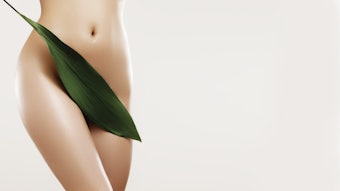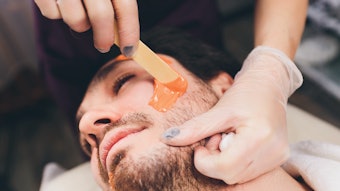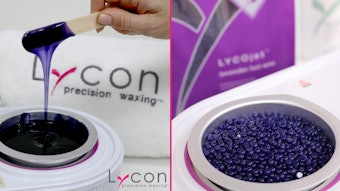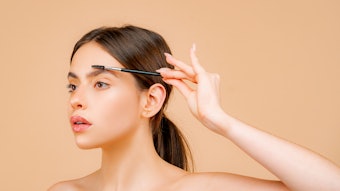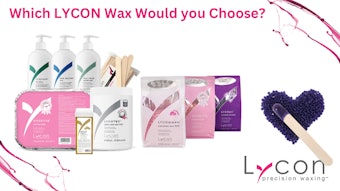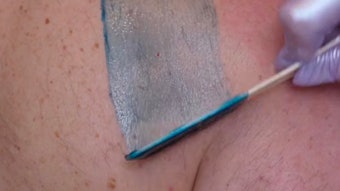
When it comes to skin type and skin condition, everyone is unique, having varied combinations of both. Many skin care services are customized according to the clients skin type and condition; waxing can follow suit.
Depilatory hair removal, or waxing, is removing the hair from the root. Can you customize a waxing service that simply pulls hair from the root? Is one type of wax and one set protocol the right action for all clients? Is waxing one size fits all? To make waxing a complete, efficient service, take into account the client’s skin type and skin condition to ensure a seamless waxing experience for both you and your client.
Skin Type
First off, skin type and skin condition are not the same. Skin type is generally genetic; however, the skin type can change with aging or illness. The skin types are oily, dry, combination and normal, which is neither dry or oily.
Oily skin has an excess of sebum, while dry skin has too little sebum. Combination skin is exactly that, a combination of oil in areas and normal or dry in other areas. Typically, combination skin is oily on the forehead and the nose, but the sides of the face may be normal or dry.
The skin type is the skin’s default mode. Outside influences such as the weather might temporarily change the skin, but the skin will default back to its genetic skin type. Skin types are not contraindications to waxing on their own.
Skin Condition
Although everyone has a skin type, not everyone has a skin condition and some people have more than one skin condition. Skin conditions are specific conditions that can occur with any skin type. There is a long list of skin conditions, but some examples are dehydration, acne, sensitive skin, rosacea, eczema, skin tags, psoriasis, moles, fungus or hives.
For example, a client might have an oily skin type, but might also have the condition of dehydrated skin, too much oil and not enough moisture. Skin conditions may be genetic or may develop over time.
Some skin conditions are contraindications to waxing. It is imperative to understand contraindications to waxing and to be able to analyze the skin to determine if it is safe to proceed.
First: Analyze
It is also important to be able to determine the skin type and skin condition of each client to create a personalized plan. Once you have determined the skin type and skin condition, you can customize the waxing experience.
So, how do you know what skin type a client has? Note what the skin type is on both the face and the area of the body that you will be waxing. Make sure you analyze the area you will be waxing and not just the face. If a client has oily skin on their face, this doesn’t necessarily translate to them having oily skin on other areas of their body. It is helpful to have a client consultation form with specific questions, such as the following.
Does your skin feel oily to the touch?
How soon after cleansing the skin does your skin feel oily?
Does your skin feel tight?
Does your skin feel itchy?
Is your skin flaky?
Is your skin reactive?
Does your skin get red easily?
The answers to the consultation questions are clues and will help you to proceed. To help determine the clients skin type, analyze the skin by looking and touching the skin. Oily skin will feel oily to the touch, due to the excess of sebum. Oily skin will look shiny.
Dry skin might look flaky or dull and feel rough. Dry skin will feel tight to the client. Dehydrated skin will look crepey and dull. The skin won’t bounce back when pressed or lightly pinched. Once you have determined the skin type and skin condition, you can create the custom waxing plan.
Customizing Waxing
The steps in a waxing protocol are the same for all clients and body areas: cleanse, prep, wax and soothe. However, the customization in the waxing protocol comes in with the products, which can be chosen specifically for each client. Even the wax can be based on specific needs.
Why do we need to customize? Why not use the same products and wax for every client? You will not achieve the best result by using the same pre and post products and wax on every person. For example, applying pre-wax oil to oily skin will result in the wax not adhering to the skin. If you apply powder for pre-waxing on dry skin, the wax will not remove properly, either cracking or sticking to the skin. This is true for both hard wax and strip wax, but especially with strip wax. Read below to help choose the right products for each step of the waxing protocol and ensure success.
Cleanse
The first step to waxing is always to cleanse the skin. Cleansing the skin creates a clean template and helps to reduce the risk of contamination due to bacteria that may be present. Cleanse the skin using a cotton round and apply an antiseptic cleanser that will sanitize the skin and remove makeup, oil or perspiration. Have two options: one alcohol-free cleanser for sensitive and dry skin and one cleanser for normal, oily and non-sensitive skin. Choosing an alcohol and fragrance-free cleansing product that is created for dry or sensitive skin will protect the skin from being irritated, over-sensitized or that makes the skin feel even dryer.
Prep
Next, you will prep the skin for waxing. Prepping the skin will make a more comfortable experience for the client and helps to ensure every hair is removed in one pass. A pre-wax oil that creates a barrier between the hair and the skin is ideal for most skin types, except oily. For oily skin, especially on the face or the back, skip the pre-wax oil. Using a pre-wax oil on oily skin will create a canvas in which the wax simply rolls off. Instead, choose a corn starch powder that will absorb the skin’s natural oil. But for dry skin, use a pre-wax oil that will hydrate the skin and help to ensure an almost pain free waxing. Pre-wax oil is beneficial to use on the arms, legs, back and bikini or Brazilian with dry skin.
Wax Choice
Once the skin is prepped to be waxed, it’s time to choose the wax that you will use. Choose a hard wax or a strip wax. Hard wax, or wax without the need for strips, is the most comfortable for the client. Strip wax is more economical and works for less sensitive areas.
Next, decide which formula is best. One size does not fit all. Have you ever removed strip wax, only to have the strip in your hand and the wax remaining on the client? The client’s skin is too dry. For dry skin, the pre-wax oil helps, but also choose a moisturizing wax. The added moisture will help the wax to release from the skin easily while removing every hair. Look for ingredients like coconut oil, paraffin, olive oil or shea butter for clients with dry skin. Clients that have oily skin will fair well with a stronger rosin or liposoluble wax. For clients with sensitive skin, avoid fragrance and beeswax, which can cause irritation. Look for soothing ingredients like aloe, azulene and lavender. A rosin-free, hypo-allergenic wax that is free of beeswax and fragrance is ideal for clients with sensitive skin. Some wax is made for specific areas like the intimate area; this can even further create a custom plan for the client.
Post-Waxing Treatment
Once the waxing has been completed, it’s time for the post-waxing product to be applied. Post waxing products are formulated to calm, cool and/or moisturize the skin. For oily skin areas that are prone to breakouts, avoid post-waxing oil. Instead, opt for a cooling gel with aloe. For dry skin, choose a post-wax oil with ingredients such as tea tree oil or jojoba oil. For acne prone skin, a post waxing product that includes a low percentage of salicylic acid will help to keep post-wax breakouts at bay.
Great Results
Not only will customized waxing service offer greater results, but your clients will be grateful you took the extra step to create a plan specifically for them, that they can’t get anywhere else. You will not achieve the best results using the same waxing products on everyone.
Cali VanAelst, L.E. has been a licensed and practicing cosmetologist and esthetician since graduating from Pivot Point in 1989. She is currently the training director for Cirépil by Perron Rigot. She was selected by New City as the “Best Waxer in Chicago” and has been featured in both Allure and Chicago Magazine as one of Chicago’s best.

